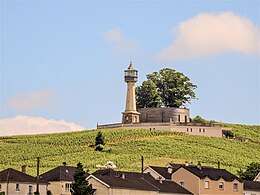
Phare de Verzenay
Presentation
Initial destination
Advertising lighthouse
Current destination
Écomusée de la vigne
Foundation
Material
Heritage value
Recensé à l'inventaire général
Website
Localisation
Localisation
Coordinates
The Verzenay Lighthouse is a lighthouse built in the early 20th century for advertising purposes, in the town of Verzenay in the Marne department, offering an exceptional view of the Champagne vineyards. It has been brought back to life as part of a vineyard ecomuseum.
History
Advertisement for Goulet champagne.
This lighthouse, made of reinforced concrete, was built on Mount Rizan in 1909 for advertising purposes for the champagne Joseph Goulet. The name of the champagne Joseph Goulet was vertically inscribed on the edge of the six sides of the building and visible until its transformation into an ecomuseum[[1\]](https://en.wikipedia.org/wiki/Verzenay_Lighthouse#cite_note-1). The name Joseph Goulet has no connection with the Goulet-Turpin[[2\].
The crowd on Sunday around 1913.
The site serves, like the mill, as an artillery observatory during the 1914-1918 war[3]. The shells from the First World War damaged the building, which was not rehabilitated. It was then ignored and overgrown by vegetation[4]. The lighthouse is owned by Heidsieck House, then by the Mumm group. The municipality acquired it in 1987 with the idea of creating a vineyard museum[5],[6]. However, the project only started in 1994 for an amount of 13.77 million francs. The whole project was designed by the architect François Wüstner, the landscape architect Jean-Marie Amelin, and the museographer Jean-Pierre Pinoteau. In addition to the restoration of the lighthouse, a new building, shaped like a barrel, houses a vineyard ecomuseum[7]. On October 3, 1999, the vineyard museum inside the Verzenay lighthouse opened its doors to the public. On September 4, 2009, the Vesle-Montagne de Reims community of communes celebrated the lighthouse's 100th anniversary, the 10th anniversary of its museum, and inaugurated the museographic renewal[4].
Role during the two world wars
Like the Verzenay mill, the lighthouse was used as an observation post during World War II. In the aftermath of the war, only the reinforced concrete tower of the lighthouse survived the shots. Around it, all the annex buildings were destroyed.
Equipments
Museum room.
The journey from the parking lot to the lighthouse is done via a footbridge. Access to the belvedere, located at 25 meters in height, after climbing the 101 steps, offers a 360° panorama of the vineyard of champagne.
Notes and references
- ↑ « Phare de Verzenay / musee de la vigne en champagne », sur cndp.fr (consulté le 16 avril 2021).
- ↑ Frédéric Carluer-Lossouarn, L'Aventure des premiers supermarchés : la révolution qui a changé la vie des Français, Paris, Éd. Linéaires/Éd. du Bois Baudry, 2007, p. 28.
- ↑ « Exposition Verzenay pendant la Grande Guerre - Commémoration - Verzenay », sur Site officiel du tourisme en Champagne-Ardenne (consulté le 16 avril 2021).
- ↑ a et b Journal L'Union, « Près de Reims, le Phare de Verzenay fête ses 110 ans »
 , sur lunion.fr, 24 février 2020 (consulté le 16 avril 2021).
, sur lunion.fr, 24 février 2020 (consulté le 16 avril 2021). - ↑ « Verzenay, une destination immanquable en Marne », sur ccvmr.com (consulté le 16 avril 2021).
- ↑ « Phare de Verzenay - Union des Maisons de Champagne », sur maisons-champagne.com (consulté le 16 avril 2021).
- ↑ « Verzenay Le phare métamorphosé en musée de la Vigne », Le Moniteur des travaux publics et du bâtiment, 19 novembre 1999 (lire en ligne
 , consulté le 16 avril 2021).
, consulté le 16 avril 2021).
See also
Bibliography
- The industrial heritage of the agri-food sector, APIC Notebook No. 1, CRDP Champagne-Ardenne Editions, 2000, (ISBN 2-86633-322-5).
Related Articles
External links
On the other Wikimedia projects:
- Verzenay Lighthouse, on Wikimedia Commons
- Site officiel

- Ressource relative à l'architecture
 :
:
* [Mérimée](https://www.pop.culture.gouv.fr/notice/merimee/IA51000627)
* [_Carthalia_](https://www.andreas-praefcke.de/carthalia/id/8790)
This document comes from 'https://fr.wikipedia.org/w/index.php?title=Phare_de_Verzenay&oldid=215648905'.







